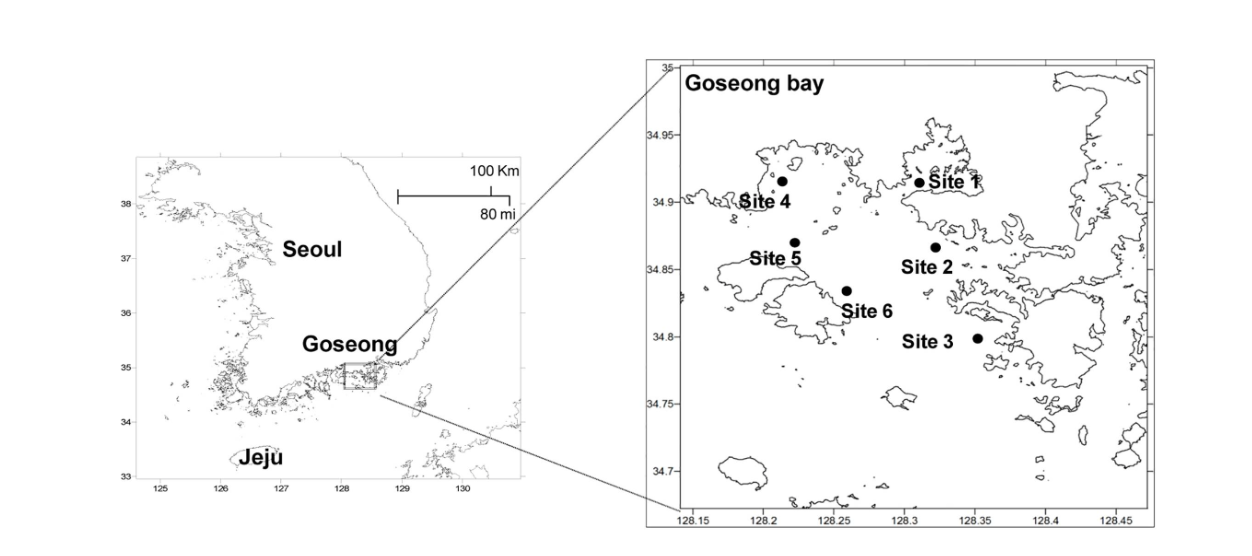This web page was produced
as an assignment for an undergraduate course at Davidson College.
Helen Webster's Genomics
Home Page
Marine
Viruses in Korea
Goseong Bay
location and the six sites of virus collection.Hwang
et al.
What was the research project?
According to Hwang et al., viruses are the most
abundant microbes in large bodies of water, accounting for 106
to109 particles
per mL of seawater. A study conducted by Dr. Hwang and collaborators,
published in 2017, takes a look at the genomic diversity of marine viruses,
and the effect of seasons on the structure of the marine viral community,
and therefore implications on the rest of the marine ecosystem. It has
previously been found that viral communities in oceans vary according to
latitude, temperature, oxygen concentration, biome, and microbial
concentrations (Brum
et al.). Knowing this about niche structure, these researchers
conducted a mass metagenomic characterization of the molecular diversity of
DNA viruses in Goseong Bay, South Korea. The researchers examined the viral
distribution, abundance, and ecosystem role of marine viruses with the
changing of seasons. Modern techniques, including next generation
sequencing, made this metagenomic study possible, as large fragments were
able to be read and sequencing, which was a previous limitation of this type
of study. The researchers hoped to gain insight into the taxonomic make up
of marine viruses themselves and in the context of the entire ecosystem.
Were they testing a hypothesis or doing discovery science?
They were doing discovery science. Hwang et al. conducted a
"metagenomic study," which means a large amount of data was collected from
the environment and surveyed in order to draw conclusions and predict
patterns. Researchers gathered samples from six sites in the Goseong Bay,
and reported their findings through organizing and interpreting the data.
What genomic technology was used?
The researchers analyzed multiple DNA libraries from samples collected
during each of the four seasons. Illumina HiSeq2000 was then implemented for
sequencing. Illumina entails synthesis by sequencing (SBS),
mass parallel sequencing DNA and detecting bases one by one in order to
build one big strand. Process was made more efficiently by combining the
ligation and fragmentation steps into a single step (known as
"tagmentation"). The pieces were then amplified using PCR.
What was the take home message?
Viral communities are similar in the different seasons. 108 viruses were
present during all seasons, and the breakdown of which viruses and their
abundance per season was found. The viral community is an important and
influential part of marine ecosystems. From knowing the viral composition,
we can further investigate the role of different viruses and how they
contribute to the overall marine habitat in terms of infection, gene
exchange, and more.
What is your evaluation of the project?
This project is useful because it offers a comprehensive
breakdown of viruses in a particular body of water. It is important because
it shows that this is most likely occurring in all bodies of water. It might
not necessarily be previously known just how much of marine ecosystems is
made up by the viral community. The study is well laid out and easy for a
non-expert to understand. Clear results and discussion help the reader to
fully understand the results and implications of the study, and how further
research can and should build on this information.
References
Hwang et al. 2017. Seasonal Dynamics and Metagenomic Characterization of
Marine Viruses in Goseong Bay, Korea. PLoS ONE. 12(1). Available from PLoS
ONE.
Brum et al. 2015. Patterns and ecological drivers of ocean viral
communities. Science. 348(6237). Available from Science.
HiSeq 2500 Sequencing Technology. 2017. Illumina, Inc. Available from Illumina.
Helen's Home Page
Genomics
Page
Biology Home Page
Email Questions or Comments: hewebster@davidson.edu
© Copyright 2017 Department of Biology,
Davidson College, Davidson, NC 28035

